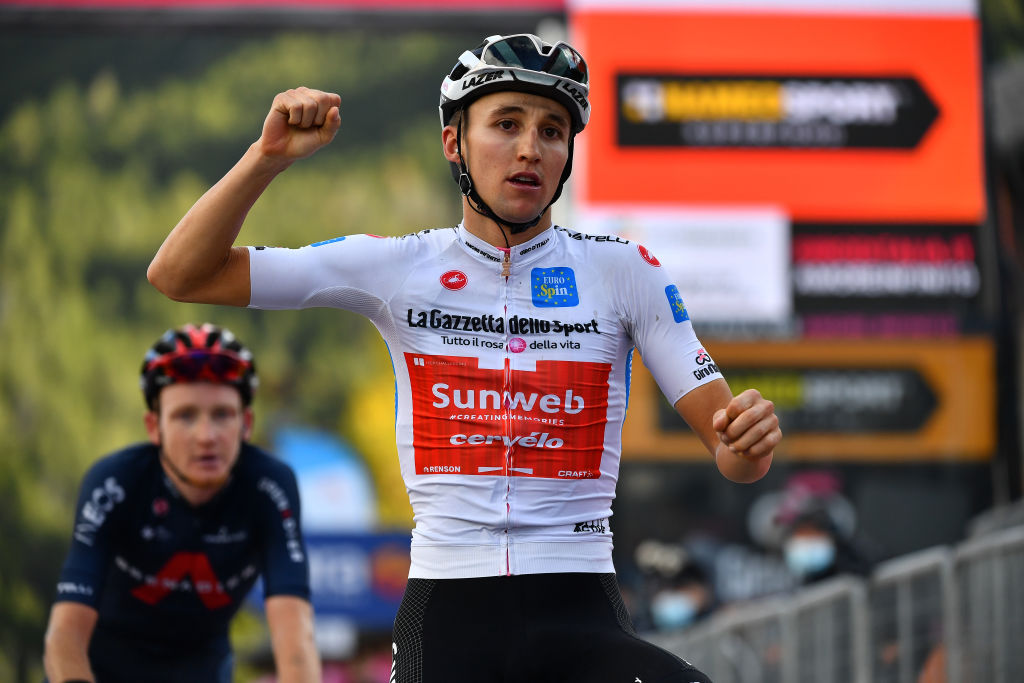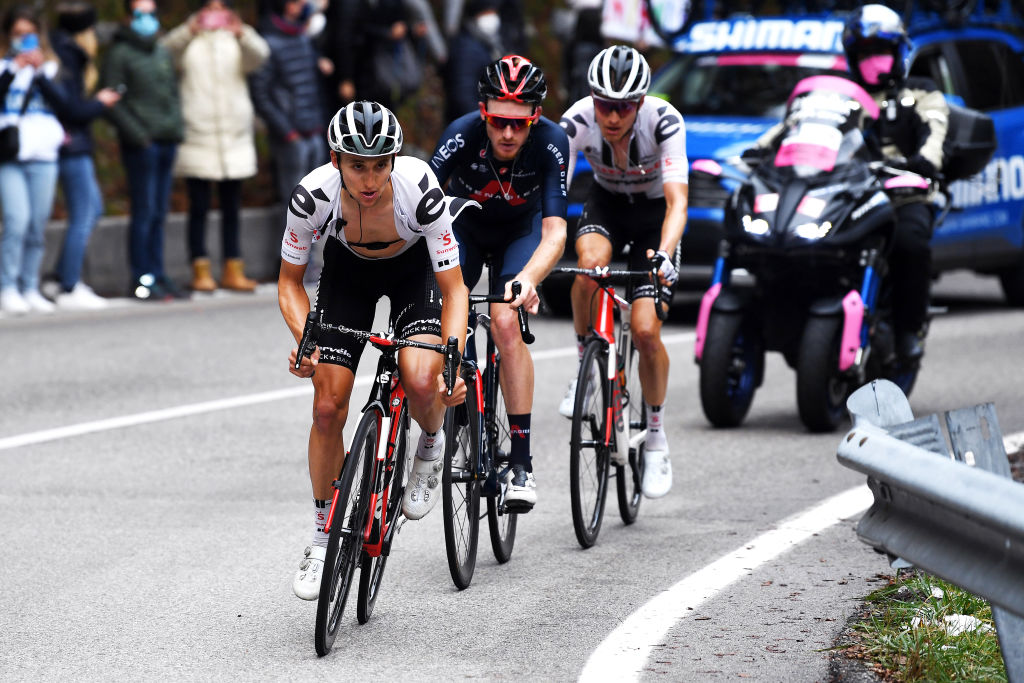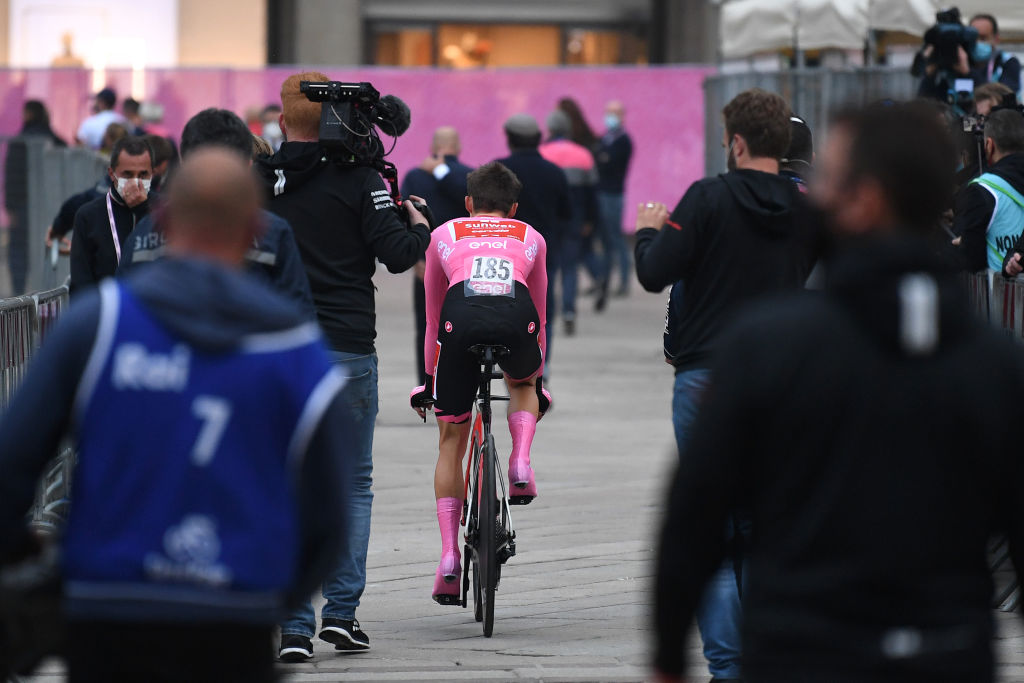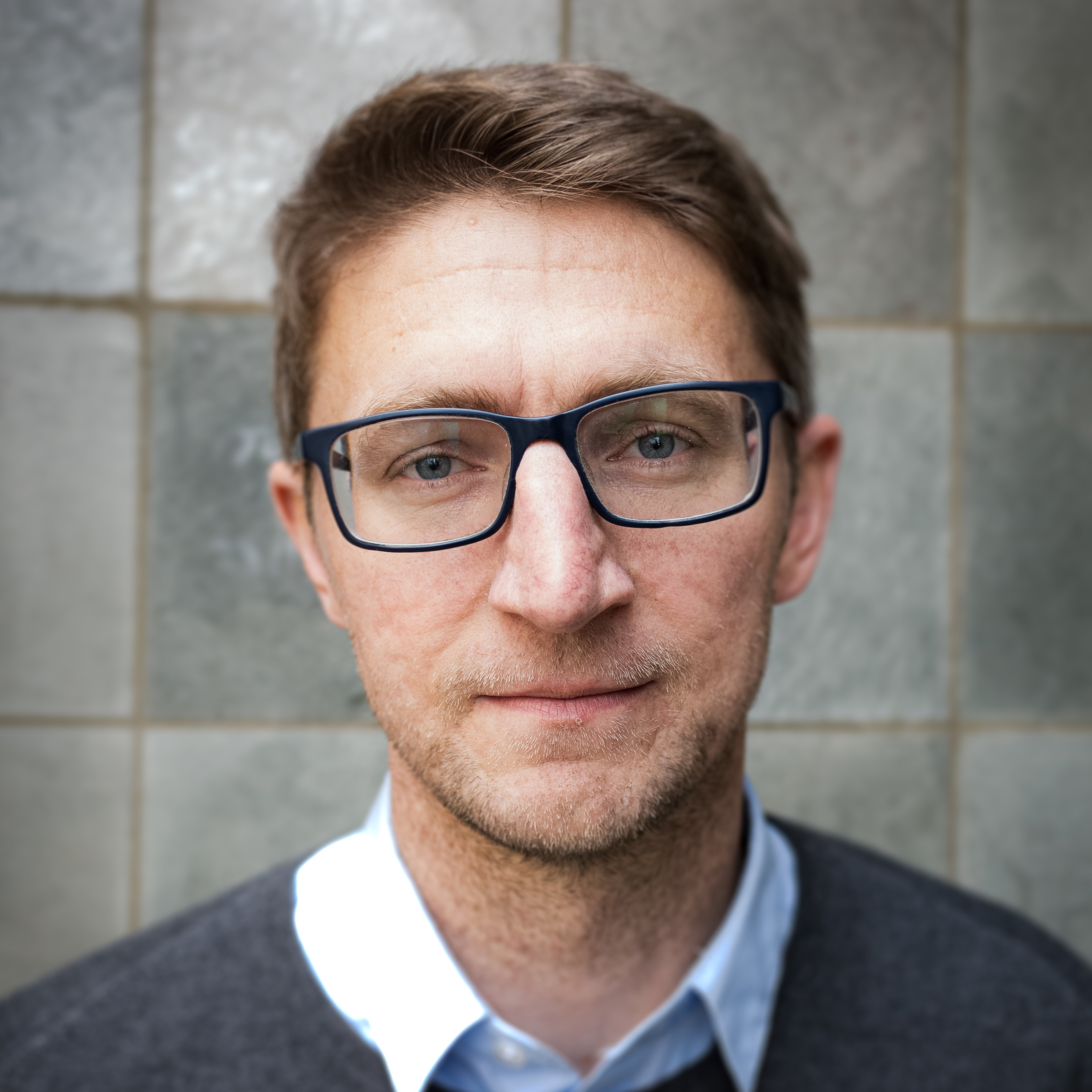Jai Hindley: Leading the Giro d'Italia was a life-changing moment for me
Australian looks ahead to 2021 after a breakout year

There’s Grand Tour tired and then there’s Grand Tour-contender tired. Jai Hindley was already familiar with the former condition from his first two seasons as a professional, but he experienced the latter for the first time at this year’s Giro d’Italia.
Riders at the front of three-week races don’t just suffer faster, they also suffer differently. The demands continue beyond the finish line: podium ceremonies, television interviews, tactical ruminations, the pressures of leadership. Hindley handled those additional rigours well to place second overall in Milan, but he could feel the toll of the accumulated mental fatigue once the race had ended.
“It was a bit different,” Hindley tells Cyclingnews. “Physically, I still felt pretty good in the last week up until Sestriere. I think it was more the mental side that was completely overwhelming. It’s not something I’d ever been through, really. It just hit me like a tonne of bricks in that last week, and when I got back home to Girona, it was just nice to sit on the couch and soak it all in and not have to do anything.”
Hindley’s transition from stage-racing hopeful to potential Grand Tour winner accelerated suddenly in the final week of the Giro, beginning with that ferocious stint of pace-making on behalf of Sunweb teammate Wilco Kelderman on stage 15 to Piancavallo, which lifted him to third overall. But even then, with Hindley still three minutes off the lead and still resolutely in the service of Kelderman, the maglia rosa must have resembled the glow of some distant fire.
The Australian only began to warm to the idea of winning the Giro at Laghi di Cancano four days later, when he claimed the stage victory and moved to within 12 seconds of Kelderman’s lead. He would reach out and touch the flame on the last weekend, taking pink atop Sestriere, and though he lost the jersey in the final time trial in Milan, he was not burnt by the experience.
Quite the opposite. Throughout the final week, Hindley carried himself with the lightness of a man who saw the big occasion as something to be enjoyed rather than endured, smiling his way through press conferences and offering joking pointers to the Italian press on how to pronounce his name: “It’s Jai like Hi.”
Even after he had been divested of the maglia rosa by Tao Geoghegan Hart, he lingered in the dusk of Piazza del Duomo, amiably recounting the experience without the faintest note of self-pity.
The latest race content, interviews, features, reviews and expert buying guides, direct to your inbox!
“I think it’s just important to take a step back and not get sucked into it too much and really enjoy the moment,” Hindley says now. “It sounds pretty cliché, but it’s not every day you get to wear the pink jersey, even if it was only for 15km. It was just, like, a life-changing moment for me.
“Just getting consistently to the point where I was really going for it in the mountain stages was great: that’s why I do bike racing, that’s why I love it. To be right up there in the mix and going for the win, it’s super enjoyable.”

Together with Geoghegan Hart and long-time race leader João Almeida, the 24-year-old Hindley was emblematic of a Giro of revelations, but while he exceeded all expectations with his podium finish, his Sunweb team was not entirely surprised by his resilience across the three weeks.
His potential as a stage-race rider had already been flagged during his amateur career. Second place in the 2016 Rás Tailteann and fifth at the Tour de l’Avenir saw him join the Mitchelton-Scott development squad the following year, when podium finishes at both the Herald Sun Tour and the under-23 Giro convinced Sunweb to offer him a professional contract.
If Hindley’s first two seasons at Sunweb served as an apprenticeship – he completed both the Vuelta a España and the Giro – then second overall at last year’s Tour de Pologne suggested he was ready to progress further. Tom Dumoulin’s departure to Jumbo-Visma perhaps helped to expedite the process. After winning the SunTour in January, Hindley’s season was built around a tentative tilt at the top 10 of the Giro – a plan that survived the pandemic-enforced hiatus.
“I think maybe guys who haven’t followed me or my career and then saw me winning that Stelvio stage would think I came out of nowhere, but there’s been a lifetime of work put in to do a ride like that,” says Hindley, who began racing with the Midland Cycling Club in Perth at the age of seven, having been introduced to the sport by his Manchester-born father, Gordon.
“I didn’t come out of U23 and start winning immediately. It’s been just steps each year, and I think that’s something that Team Sunweb is really good at, developing guys – even guys who aren’t winning everything in their first year as a pro.”
At Tirreno-Adriatico, Hindley’s encouraging eighth place on the summit finish at Sassotetto, a minute down on Simon Yates, suggested that he had coped well with the lockdown.
“It was a key moment: from then on, I just had a lot more self-belief that I could do something like that consistently,” says Hindley.
That confidence seemed to metabolise as the Giro drew longer, particularly once he had digested an early off-day at Mount Etna on stage 3.
“I had really bad stomach cramps, and it was the biggest hit on my race, but at the time, I was pretty happy not to lose five or 10 minutes,” he says. Hindley rode reliably in the leading group alongside Kelderman thereafter to lie in the top 10 at the end of the second week, but the tone of his race – and his entire career, perhaps – would change on the 14.4km of smooth but steep road above Aviano on stage 15.
Piancavallo
On a summit finish, everybody rides towards the same destination, but many are going in different directions. At the foot of Piancavallo, for instance, Vincenzo Nibali was still in contention to win the Giro. By the top, he was relegated to the role of outsider. For Hindley, meanwhile, the climb served as a dividing line between the promise of youth and a future as a Grand Tour contender.
He rode in support of Kelderman all the way up the mountain, but on reaching the chillier air at the summit, he was suddenly in line for a podium finish of his own. Hindley entered the Giro nurturing quiet hopes, but not even he had expected them to flower so dramatically in the space of one climb.
“It was pretty surprising, actually, because when we hit the bottom, we were basically going full team time trial mode and I was going super deep, which was a bit worrying mentally,” Hindley says. “But then we kept hearing on the radio all the names that were being dropped and that also pushes you on a bit more.”
Hindley took up the reins at the head of the front group with 6km or so remaining, after Sunweb teammate Chris Hamilton had swung off. Men like Nibali and the maglia rosa, Almeida, were already distanced, and only Geoghegan Hart and Kelderman would hold Hindley’s wheel all the way to the summit.
“When Chris Hamilton pulled off, I was thinking, 'Oh, shit, there’s still a long way to go,’ but I was hearing on the radio, ‘Just keep it going for as long as you can,’ and I didn’t really blow up until a few hundred metres before the line. To be able to just throw it down on a hilltop finish in a Grand Tour was something I’d wanted to do and never been able to do it, so to do it in the Giro was crazy cool.”
At the Giro, like at the Tour de France, riders and coaches alike marvelled at the prodigious power output required to race on the front in the mountains in this condensed, post-lockdown season. Two days before Milan, Trek-Segafredo coach Paolo Slongo outlined the high level of the race's unexpected podium contenders by noting that “even the best Nibali might not have been able to compete with the top three in this Giro”. During that effort at Piancavallo, however, Hindley was neither inspired nor inhibited by his numbers, citing his preference not to keep tabs on his power output in real time.
“When I race, I just don’t have power or heartrate on,” Hindley says. “If you look down during a race and you see you’re already doing crazy numbers, then when someone attacks, you’re thinking, ‘Shit, I’ve gone over my threshold for too long and I’m going to blow.’ For me, personally, I prefer to race more old-school style and go off feel.”
Rather than eyeing his power data, then, Hindley spent the last Saturday of the Giro trying to read Geoghegan Hart’s pedalling and shoulders on the final climb to Sestriere. Two days earlier, they had been the only two men to match Geoghegan Hart’s Ineos teammate Rohan Dennis’ stratospheric tempo on the Stelvio. Although Kelderman had taken the pink jersey that same afternoon, Sunweb were prepared for Ineos to repeat the onslaught on the twin ascents of Sestriere, and mindful that Hindley would be better equipped to withstand it.
“If Rohan was up for it, then I pretty much knew they were going to do the exact same thing as they had done on the Stelvio,” Hindley says. “It wasn’t a shock to me when Rohan started dishing it out, but I just knew I had to follow Tao, and that’s what I did again. We’d already discussed as a team that I could do my own race if Wilco did get dropped and the gap was at a certain point. And it was actually Wilco who made the call on the radio, which I thought was pretty professional of him.”
Sunweb’s tactics on the Stelvio stage had been questioned by Kelderman, but Hindley evinces no regrets at how the race played out.
“I don’t think the team made any bad decisions,” he says.
At Sestriere, in any case, it was down to him. Hindley made no fewer than five attempts to break Geoghegan Hart in the final three kilometres, but nothing could separate the two young contenders, either on the day or on the general classification. Although Hindley took the pink jersey that afternoon, he was locked on the same time as Geoghegan Hart going into the final time trial.
“The first time up, when Rohan was throwing it down, I could tell Tao was hurting because at some points he was telling Rohan to slow down and that was giving me a lot of confidence because I still felt pretty good,” Hindley says. “But once we’d got the gap, Rohan could ride a bit easier and Tao recovered a fair bit. He was super strong the last time up, and I couldn’t get rid of him. I threw the kitchen sink at him, but I just couldn’t get rid of him.”
A day later, as per the hazy form guide, Geoghegan Hart overcame Hindley in the time trial to win the Giro by 39 seconds.
“I knew on paper that Tao was the favourite to win the Giro with that TT, but I didn’t think I didn’t have a chance either,” Hindley says. “In the 21st day of a Grand Tour, you could have the best day of your life or you could fall off the start ramp.”

2021
Hindley is speaking from his European base in Girona, where he will remain for the winter as COVID-19 quarantine restrictions made the usual trip back home to Perth unfeasible. It’s not the off-season the Australian wanted, but perhaps it’s what he needed after a late finish to the 2020 campaign.
“It’s different, because usually at this time I’d be in Oz and training full gas for the National Championships and the Tour Down Under,” he says. “It’s not great to miss out on going back, but at the same time it’s a chance to stay here and build up slowly to focus on racing in Europe next year.”
Like most of the WorldTour peloton, Hindley is unsure of when his 2021 season will begin and where it will take him. The pandemic means that not every event on the calendar is guaranteed to take place as planned, while the routes of the Giro and Vuelta a España will not be revealed until the new year.
“I honestly don’t know any of the races I’m doing next year. The Giro route still hasn’t been announced, and that could play a big part,” he says. “I definitely want to try for the GC in a Grand Tour again. Wearing a Grand Tour leader’s jersey is something pretty special and something I’ll keep dreaming of.”
One certainty is that Hindley will be wearing a new jersey in 2021 – the final year of his existing contract – as DSM have taken over from Sunweb as team sponsor. He will also dovetail his ambitions with those of a new general classification leader. Kelderman has left for Bora-Hansgrohe, but Romain Bardet joins DSM after almost a decade at AG2R.
“I think it’s pretty exciting. I don’t actually know Romain personally, but from what I’ve heard he’s a really nice guy,” says Hindley. “It will be good to learn from him where I can, and I think it’s not really an issue going into a race with multiple GC leaders. Actually, I think that’s quite normal now. A lot of teams take multiple GC guys to a race, and it’s just something you have to adapt to.”
Hindley was among the leading lights of an emerging generation of riders who so illuminated the condensed slate of autumn racing. It remains to be seen if the trend of young winners will continue in a 2021 season that might – hopefully – be run off without significant stoppages. But wherever the new campaign takes him, Hindley knows that he will be measured against the yardstick of his breakout performance in October. He smiles at the prospect. He already wore the burden of Giro leadership lightly. No need to change now.
“For sure, it’s added pressure and the bar has risen, but I’m going to keep doing what I’ve been doing,” he says. “I’m going to keep enjoying it. That’s all I can do, really.”

Barry Ryan was Head of Features at Cyclingnews. He has covered professional cycling since 2010, reporting from the Tour de France, Giro d’Italia and events from Argentina to Japan. His writing has appeared in The Independent, Procycling and Cycling Plus. He is the author of The Ascent: Sean Kelly, Stephen Roche and the Rise of Irish Cycling’s Golden Generation, published by Gill Books.